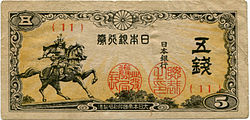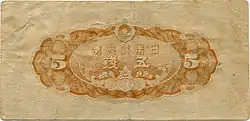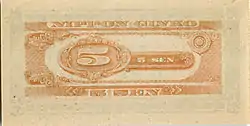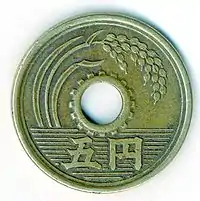5 sen note
The 5 sen note (五銭紙幣) was a denomination of Japanese yen that was issued from 1944 to 1953 in paper form. Five sen notes were worth one-twentieth of a yen making them the lowest subsidiary yen banknote ever made. These notes are broken up into two types which were issued before and after World War II. Those issued before the war filled a void left when 5 sen coin production became difficult. The Japanese government later issued notes in a unsuccessful attempt to curb inflation. Neither of these notes are currently legal tender as the "sen" was abolished in 1953 when the yen system was modified to exclude the old fractional currency. These banknotes are now easily collectable as they were issued in large amounts.
| (Japan) | |
|---|---|
| Value | 1⁄20 Japanese yen |
| Years of printing | 1944–1948 |
| Obverse | |
| Design | Kusunoki Masashige Ume (Japanese Plum) (A) |
| Reverse | |
| Design | Paulownia "5 Sen" in Latin (A) |
History
Five sen notes were first issued towards the end of World War II as supplies had run out to produce more five sen coins.[1] These coins were initially produced in Aluminium bronze after the Second Sino-Japanese War broke out in 1937. The alloy for the five sen coin was changed to Aluminium, and eventually to tin as materials were needed for military supplies. Coins made out of tin were first produced in March 1944, and eventually the Japanese government needed more.[2] The Second Sino-Japanese War had become part of World War II, and allied forces were inching closer to victory. Although the Japanese could obtain the alloy from their still occupied Southwest Asian[lower-alpha 1] colonies, allied air superiority and control over the seas made the transport of tin difficult.[1][3] Five sen notes were first issued on November 1, 1944 with a design featuring Kusunoki Masashige on the front.[4][5] The depiction of this Kamakura period samurai led to the first series being known as "Masashige notes".[6] The design on the back has the Government Seal of Japan also known as the "Paulownia Seals" after the Paulownia flower. These notes were issued in large amounts due to rising inflation.[6]
The last "5 sen" notes were issued on May 25, 1948 as part of the "A series".[7][8] These are notable for being the smallest sized banknotes ever issued by the Japanese government at 48mm x 94mm.[8] The front design features the Ume ("Japanese plum") flower, while the reverse shows the value "5 Sen" in Latin script. In order to curb post-war inflation, the Bank of Japan invalidated all banknotes worth over a yen and issued new notes.[9] Those in the "A series" with the exception of the 100 yen note were all poorly made due to post-war turmoil.[9] Five sen notes of the "A series" were printed by two different private sector companies which led to "big differences" and counterfeiting.[9] These notes eventually lost their meaning as the worsening inflation did not subside.[10] Both of these issues were eventually demonetized at the end of 1953 when the Japanese government passed a law abolishing subsidiary notes in favor of the yen.[11] Currencies of less than one yen were rarely used by this time due to excessive post-war inflation.[12]
Both of these banknotes are now bought and sold as collectibles depending on condition. Five sen "series A" (1948) banknotes are slightly more scarce than their counterparts, though both were produced in large amounts.[6] Five sen notes in general are common and inexpensive as there are a large amount of surviving examples. Notes made in error such as those with a cutting misalignment, those with missing design features, and those with unusual ink leakage carry a much higher value.[13][14]
Designs
| Series | Obverse | Reverse |
|---|---|---|
| 1944 (昭和19) ("Masashige") ("First issue series") |
 |
 |
| 1948 (昭和23) ("A series") |
 |
 |
See also
Notes
- This is assuming travel from mainland Japan.
References
- Reiji Aoyama (1982). New Revised Money Notebook, History and Collection Guide for Japanese Coins. Bonanza. pp. 195–196.
- Ministry of the Treasury (March 8, 1944). "Kanpō". 5143. National Printing Bureau.
- "5銭錫貨(2)" (in Japanese). www.buntetsu.net. Retrieved April 7, 2017.
- Nihon Ginkō Chōsakyoku (1961). Financial Chronology of Japan. Bank of Japan, Economic Research Department. p. 43.
Nov . 1 Bank notes in small denominations issued ( 10 sen and 5 sen )
- C. Frederick Schwan, Joseph E. Boling (1995). World War II Remembered: History in Your Hands, a Numismatic Study. BNR Press. p. 540.
- "5銭札の価値と買い取り価格を紹介". Kosen Kaitori (in Japanese). Retrieved December 5, 2020.
- Official Gazette. English Edition. 1948. p. 7.
Japan Bank Note of 5 sen which will be issued as from May 25, 1948
- "History of Japanese Paper Currency". National Printing Bureau. Retrieved December 5, 2020.
- "A5銭券" (in Japanese). www.buntetsu.net. Retrieved December 5, 2020.
- "発行の経緯 (1945)". Pepper's Square (in Japanese). Retrieved December 5, 2020.
- "小額通貨の整理及び支払金の端数計算に関する法律" [A law of the abolition of currencies in a small denomination and rounding off a fraction, July 15, 1953 Law No.60]. www.shugiin.go.jp. Archived from the original on June 28, 2002. Retrieved December 5, 2016.
- "1円未満のお金が使えなくなったのはいつからですか?". Bank of Japan (in Japanese). Retrieved October 27, 2020.
- "買取価格が高い日本銀行券 楠公5銭紙幣". Antique Coin Info (in Japanese). Retrieved December 5, 2020.
- "買取価格が高い梅5銭札(日本銀行券A号五銭紙幣)". Antique Coin Info (in Japanese). Retrieved December 5, 2020.

